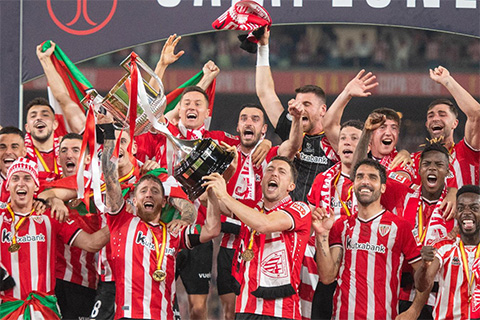
Athletic Club is born
The British 'foot-ball' arrives in Bilbao via the River Nervión
The love of a new sport
Football emerges in Biscay in the late 19th century as Bilbao and its surrounding areas experience a period of rapid industrial development. The sport was initially brought to Bilbao by British migrant workers and young Basques who had studied in Britain. The enthusiasm for this new sport inspires the birth of Athletic Club in 1898.
1889
Reports
The Sunderland Daily Echo reports on a match played in Bilbao between English sailors.

1894
Zamacois Gymnastic Society
The Zamacois Gymnastic Society is created in Bilbao, the seed that became Athletic Club.

1898
Foundation
Athletic Club is founded.

First trophies
Matches in Lamiako and the first Copas
Debut with a victory
Athletic Club play their games in Lamiako, Leioa. In 1902, Athletic wear their famous blue-and-white strip for the first time, make a foreign debut and win the first ever Alfonso XIII Coronation Cup. The Club inscribes its Statutes, integrates Bilbao FC and creates the Athletic Club Branch in Madrid.
1901
Statutes
Athletic Club’s first statutes (1901) with 33 founding members.

1902
First crests
With the blue and white colours of the kit Athletic wore until 1910 along with the initials AC in the centre.
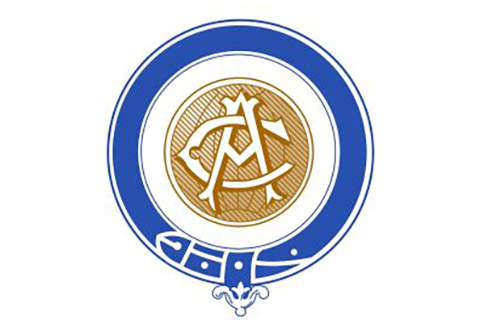
1902
The first title-winning team
The 1903 Copa winners Athletic pose in their blue and white kit. They won three consecutive trophies starting in 1902.
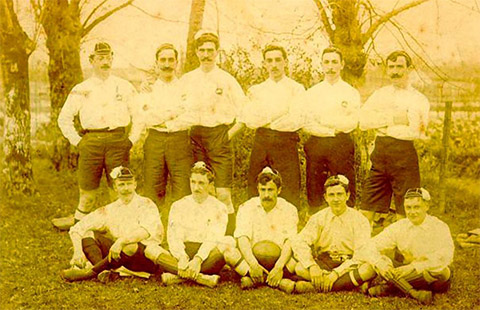
In red and white
San Mamés Stadium opens
No foreigners in the line-up
Athletic Club players turn out in red and white for the first time and the Club decides to compete without foreigners. The team leaves Lamiako and after a brief hiatus in Jolaseta (Getxo) they settle permanently in Bilbao in 1913. Their new home is San Mamés, which fans affectionately nickname ‘The Cathedral’. The Royal Spanish Football Federation is also officially founded in 1913.
1910
Red-and-White shirt
Athletic Club unveiled its red and white shirt for the first time in a friendly match against Sporting de Irun in Amute (09/01/1910). The Board of Directors had entrusted Juan Elorduy, an Athletic Madrid footballer, come back from a trip to England with a batch of blue and white shirts in the style of Blackburn Rovers, but Elorduy instead brought back Southampton's red and white stripes, the colours of the flag of Bilbao.

1911
With home-grown footballers
During the Copa tournament held at Jolaseta in April 1911, several of the participating teams denounced Athletic for improperly fielding foreigners. From then on, Athletic Club would compete only with home-grown players, thus giving birth to the philosophy that today distinguishes it from any other team in elite football.

1913
Inauguration of San Mamés Stadium
After spending several seasons at different grounds and on playing on pitches in Lamiako (Leioa, 1901-1911) and Jolaseta (in Getxo) Athletic achieved its dream of having a ground in the city of Bilbao. It rented a plot of land adjacent to the San Mamés nursing home and built a stadium that was inaugurated with a match against Real Racing Club de Irun on August 21, 1913.

The League begins
First professional players
Goodbye to amateur football
Professionalism gradually seeps into the Athletic Club squad and we say goodbye to the last generation of amateur footballers such as Carmelo Goyenechea. Athletic are now part of a new 10-team domestic league competition called ‘La Liga’. The Club expands its sporting sections and in 1923 celebrates its Silver Anniversary.
1924
The membership card
Membership cards are created for Athletic Club fans.

1922
The legend of Pichichi
Rafael Moreno Aranzadi, Pichichi, becomes Athletic’s first great legend. On top of netting the first goal at San Mamés, he scored 83 times in 89 matches and since the 1950s the trophy La Liga's top goalscorer has borne his name. He died from typhoid fever in 1922 at the age of 29. Soon after, a bust of his image was placed in San Mamés. Opponents visiting The Cathedral for the first time still lay a bouquet of flowers next to this statue.
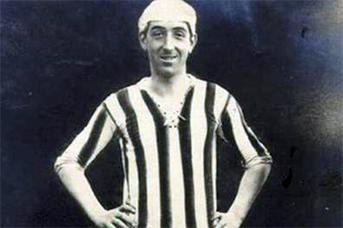
1928
La Liga begins
The 1928-29 season brought a new competition: La Liga. Athletic Club was one of the ten participating teams in that first season. They finished third but then went on two win the next two editions.

War and glory
The Civil War interrupts Athletic's dominance
Years of titles and years of difficulties
This is the most successful period in Athletic Club’s history. There are numerous titles, international players and goal-scoring records which still stand to this day. But due to the outbreak of the Spanish Civil War, all competitions are suspended between 1936-1939. The Club is hindered and the team disintegrates. These are years of strife and exile.
1930
Mr Pentland and the doubles
Fred Pentland, Athletic's first great manager, coached the side in two separate spells (1922-26 and 1929-1933). He also achieved two consecutive league and cup doubles. A club icon, just like his trademark bowler hat.

1931
Biggest league win and a second double
Biggest Athletic win in the history of La Liga: Athletic beat FC Barcelona 12-1 in a match at San Mamés on February 8, 1931

1934
The first historic frontline
Athletic's first historic frontline, made up of Lafuente, Iraragorri, Bata, Chirri and Gorostiza, won three La Liga titles and five Copas in the five seasons they played together.

Athletic Club bounces back
Athletic's post-war reconstruction
Athletic Club keep the League trophy
The effects of the Civil War weaken Athletic socially, economically and on the pitch. The club rebuilds and places its trust in youth. Led by a historic frontline, the youngsters form the base of the first side to be permanently awarded the League trophy and they also win a third Copa del Rey. The club celebrates its first 50-year anniversary.
1941
Change of name
Athletic Club was forced to change its official name to Atlético de Bilbao after the Franco Regime imposed the 'Spanishisation' of names on all teams.
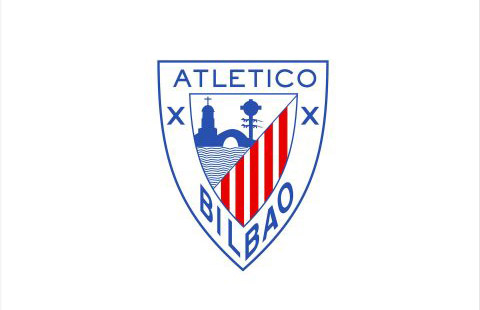
1946
The second history-making strike force
Iriondo, Venancio, Zarra, Panizo and Gainza. The most remembered attacking quintet in Athletic history.

1947
Biggest win in the Copa
Biggest win by Athletic in a cup tournament. As they did in La Liga against FC Barcelona, Athletic scored 12 goals against their opponents (RC Celta Vigo) in the Copa, 8 of which were scored by Gainza: Athletic 12 – Celta 1 (18/05/1947)

Eleven local lads
Athletic's European Cup debut
The San Mamés Arch
This is the time of "the eleven villagers", symbols of Athletic and our youth academy. New titles see the club’s popularity grow, there’s a first European Cup appearance and the first Fan Clubs are formed. San Mamés changes its look: the new Main Stand and the Arch - an icon of industrial Bilbao - are built.
1950
The first supporters’ club
The Peña Gainza de Minglanilla (Cuenca) became Athletic Club’s first official supporters’ club.

1956
European Cup debut
After winning the 1955-56 Liga, the team made its debut in the newly created European Cup. They eliminated Porto and Honved and lost against Manchester United after an unforgettable first leg at San Mames (5-3) in the snow.

1958
Copa title
Copa victory: The 11 Villagers defeat Alfredo Di Stéfano’s Real Madrid in the Santiago Bernabeu Stadium.

The youth academy grows stronger
Athletic Club Under-18s and Bilbao Athletic take shape
The new generation of Lions
Before Spanish football incorporates foreign players, the club reinforces its commitment to youth. Athletic Under-18s (1960) and Bilbao Athletic (1964) are created. In addition, Lezama, the first purpose-built football academy in the country, is designed (1969). This new generation of Lions, with José Ángel Iribar as goalkeeper, end the decade with another Copa title.
1961
Athletic Club Under-19
Creation of the Athletic Under-19 team in the 1961-62 season under the presidency of José Luis Garay. The team were runners-up in the Copa in their first campaign and won the title consecutively for the next five years.
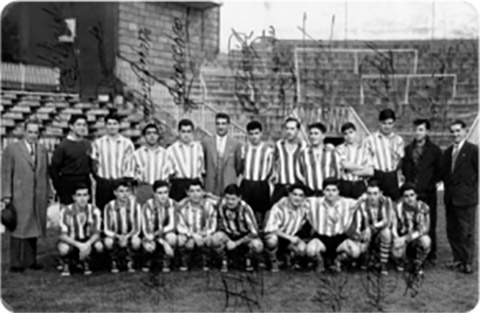
1962
Jose Angel Iribar
Début of José Ángel Iribar, ‘El Chopo’, aged 19 in a 1962-63 La Liga game. He would become one of the club's great legends over 18 seasons, defending the red and white goal. He holds the all-time record with 641 matches played for Athletic.
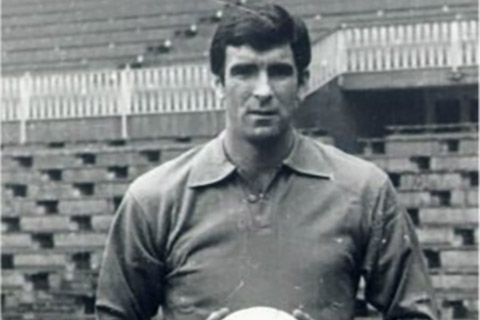
1964
Bilbao Athletic reserve team
Although Athletic had already had a team with that name at the end of the 1930s, in 1964 it was created as a subsidiary of the first team. It began its journey in the regional category under the control of Piru Gainza, first, and then Rafa Iriondo, and in just five seasons it reached the Segunda Division.
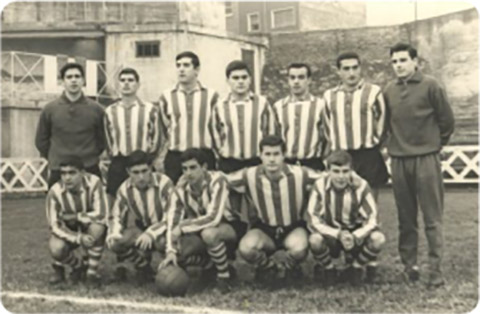
Lezama Academy
All-round development and high-performance training
First UEFA final
Athletic Club opens Lezama Academy, celebrates its 75th anniversary with another Copa title and holds the first Fan Clubs Congress (Bailén, Jaén). The team, strengthened by several signings, reaches a European final for the first time. After the political regime change, the Club asserts its democratic principles by stating, “one member, one vote”.
1971
Inauguration of Lezama
Inauguration of the football school in Lezama (Bizkaia), the first in Spain, in the 1971-72 season, under the presidency of Félix Oráa, with three pitches and a building that included living quarters and changing rooms. The facilities were later expanded to include four more pitches and an indoor sports centre.

1972
Return to original name
The Club returned to its original name, Athletic Club, after the decree banning team names containing foreign words was repealed.
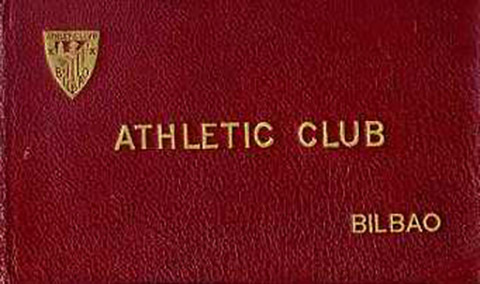
1977
First European final
Athletic Club played its first European final (UEFA) against Juventus FC. After the first leg in Turin ended 1-0, the Lions won 2-1 at San Mamés, but the double value of away goals prevented them from lifting the title.

The ‘Gabarra’
New titles and iconic celebration on the River Nervión
The official anthem
After a long wait, the Lions win two La Liga titles and one Copa del Rey. Vast crowds line the riverbanks as Athletic’s players take to the River Nervión in La Gabarra (a small barge) to celebrate their victories; a true highlight in the history of Athletic Club and Biscay. San Mamés hosts the World Cup. The Club brings out an anthem and opens its headquarters: Ibaigane Palace.
1982
First elections
First elections to elect a president on the basis of universal suffrage among all its members, a measure promoted by Jesús María Duñabeitia, president of Athletic from 1977 to 1982.

1983
A Liga title after 27 years: The Gabarra's first voyage
The achievement of winning the 82-83 La Liga, after a 27-year wait, in a thrilling last round of matches in Las Palmas, triggered wild scenes in Bilbao, where crowds of people gathered to welcome their team. The La Gabarra barge, which has since become a symbol of the club's success, took the champions along the estuary in front of hundreds of thousands of Athletic supporters.

1984
The fifth double
In the 1983-84 season, Athletic Club achieved the fifth double in its history after winning La Liga on the last day in an unforgettable match against Real Sociedad and the final of the Copa against FC Barcelona at the Bernabeu. Obviously, they also won the Supercopa, having won both competitions.

The Centenary
Up against a new challenge: the Bosman ruling
The first 100 years
This is the first decade without a trophy in Athletic’s history. After the Bosman ruling, the club must rise to the challenge in order to keep competing. Despite everything, the Zurigorri continues to play in Europe, finishes second in the league and qualifies for the Champions League. The club celebrates its first Centenary.
1992
SADs (Public limited sports companies)
The La Liga clubs became Public Limited Sports Companies (SADs) thanks to the fiscal consolidation plan in view of the huge debts accumulated. Only Athletic Club, FC Barcelona, Real Madrid and CA Osasuna remained as clubs. In 1999, Athletic approved its current articles of association
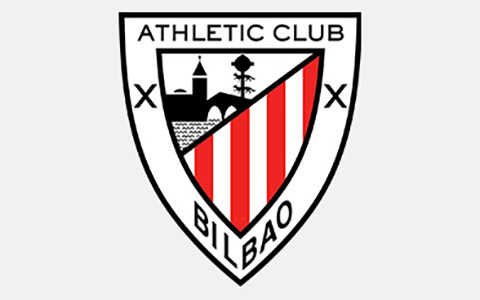
1998
Centenary in style
Athletic celebrated its centenary in the best way possible, taking the runners-up spot in the 1997-98 La Liga, which opened the doors to the UEFA Champions League for the first time, having taken part in the European Cup three times in its history.

Athletic Club Women
The Lionesses are formed, and turbulent times for the Club
The Lionesses in the elite, the Lions in trouble
In the context of globalised football, the Lions are less competitive. Some seasons they only just manage to avoid relegation from La Liga, but in others they play in Europe, and they reach the Copa del Rey final for the first time in 24 years. The Club founds Athletic Club Women and the Lionesses win four league titles.
2002
Début of the women’s team
After merging with Leioa EFT, a club founded in 2000 and playing in the Superliga, Athletic Club made its debut in the top flight of women's football. It did so in Lezama on October 17, 2002 against AD Torrejon on the first day of a championship that it would end up winning.

2004
Biggest win in European competition
On December 16, 2004, the Lions achieved their biggest win in Europe by defeating Belgian side Standard Liege 7-1. It was the fourth match in the UEFA Cup group stage and featured goals by Ezquerro (3), Yeste, Iraola, Del Horno and Etxeberria.

2005
First League trophy
Athletic Club Women win three league titles in a row, becoming the first team to be permanently gifted the trophy.

A brand-new San Mames
New stadium, new trophies
The reward after a long wait
After a century playing in the same ground, Athletic opens its new stadium in 2013: San Mamés, the new Cathedral. In this decade, Athletic Club are runners-up eight times. The Lions reach the Europa League final and the Copa del Rey final twice. The Lionesses are four-times runners-up in the League and twice in the Copa. The compensation comes in 2015-16 when the men’s team win the Spanish Super Cup - our first trophy in 30 years - and the women’s team take home the league title.
2012
Second European final
After the 1977 final against Juventus, Athletic Club reached its second continental final (UEFA Europa League) after a brilliant run in the competition. They lost in Bucarest against Atlético de Madrid in the final.

2013
The Cathedral: farewell and inauguration
100 years after its inauguration, the legendary Cathedral bade farewell with a friendly match against a team from Bizkaia and made way for the new, state-of-the-art San Mamés, which made its début with a LaLiga match against RC Celta on 16/09/2013.

2015
Supercopa winners
After many years of trying, the men's first team returned to title-winning ways. They beat FC Barcelona in the Supercopa after an unforgettable 4-0 win at San Mamés and a 1-1 draw in the second leg at the Camp Nou.

Supercopa and pandemic
Bittersweet emotions
Three finals in the same season
For Athletic, the outbreak of the pandemic at the beginning of 2020 had a decisive impact on the start of a promising decade. The football world in general suffered as a result of COVID-19, which left the stadiums without their essence: fans. In the midst of this uncertain panorama, 2021 began in style, the Lions beat Real Madrid and FC Barcelona on the way to Supercopa glory. What’s more, Athletic played two Copa del Rey finals in the space of two weeks (the postponed 2020 final against Real and the 2021 edition, against Barça).
2021
An unforgettable trophy
The Lions win the 2021 Supercopa by defeating Real Madrid 2-1 in the semi-finals and beating FC Barcelona 3-2 in a final to remember.

2021
Two Copa finals without reward
The historic feat of playing two Copa finals in the same year, in April 2021, against Real Sociedad and FC Barcelona, could not be capped off with the coveted trophy.

2024
The long-awaited Copa, 40 years later
6 April 2024. A day to remember. After losing six finals since the 1984 double, Athletic are once again champions of their favourite competition. The 25th Copa arrives in Seville - with tens of thousands of Athleticzales travelling to the city - following an agonising match against Mallorca which ended with a triumphant penalty shoot-out. Bilbao turns out five days later to see La Gabarra set sail after spending forty years on the sideline.
